The Iveagh Markets

The Iveagh Markets were built early in the last century by the Guinness family to house street traders who had been displaced by the construction of the nearby Iveagh Trust housing development on Patrick Street, and was handed over in trust to Dublin Corporation.
By the 1980s the building had become very rundown and eventually closed in the 1990s. In 1996, the council announced it was seeking a private developer to regenerate the market. The following year, Temple Bar hotelier Martin Keane secured the tender, with an agreement that the title of the market would transfer to him once the redevelopment was completed.
The redevelopment has yet to start and the building is now in a ruinous condition and legal disputes as to its ownership are ongoing.
The council has agreed to undertake structural safety works to the building and said it is currently evaluating tenders for a design team to oversee “essential stabilisation works”. Repairs to the roof and walls are due to start next year that will secure the structural fabric of the building and allow for the development of reuse proposals going forward.
RM Block
[ The Iveagh Markets: can a former Dublin glory be saved?Opens in new window ]
The council said it was still involved in a number of legal proceedings in relation to the Iveagh Markets and could not comment further. Mr Keane did not respond to queries. Funding of €9 million for essential conservation work to halt the structural decline of the Iveagh Markets in Dublin’s Liberties was approved by the Government this week. – Olivia Kelly
Victorian fruit and vegetable market
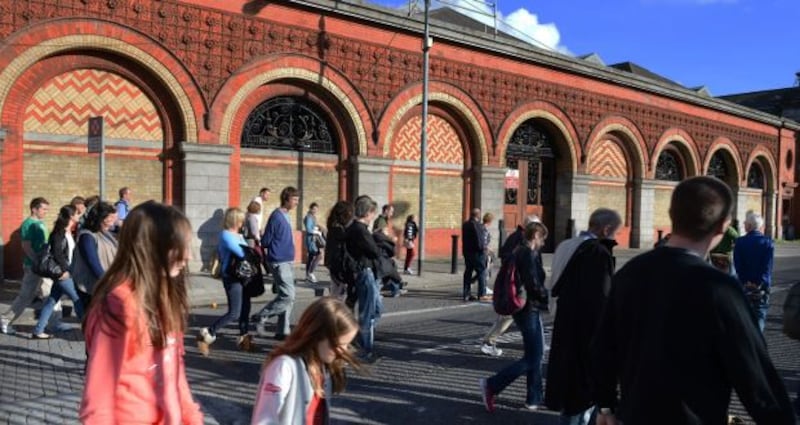
Dublin’s Victorian fruit and vegetable market on Mary’s Lane, between Capel Street and Smithfield, was closed by Dublin City Council in 2019 to make way for its redevelopment. At the time it said it would begin the tender process for its redevelopment as a continental-style food market within months and hoped to have the new market operational by 2021.
Last February, Cotter Naessen Architects were appointed to undertake detailed design and prepare a tender for conservation and refurbishment works. A construction tender is due to issue by the end of this year, the council said. “When this construction phase is under way a tender process to engage an operator to fit out and operate the new Retail Market will issue”.
The redevelopment of the market was first proposed by the council in 2002. Following three years of planning, the Markets Framework Plan was published in 2005, with the refurbishment of the market as one element of a retail, apartment and office complex of up to six storeys.
These plans did not survive the economic crash and in 2011 the council announced considerably more modest revamp of the building as a retail and wholesale food market. The following year it began repairs to the roof and in 2013 it drafted plans for the redevelopment with the intention of opening the new market in mid-2015.
However, the development again stalled when it emerged later that year that vacant possession of the hall was required for the work to take place. The council now plans to redevelop the market for retail only. – Olivia Kelly
Aldborough House
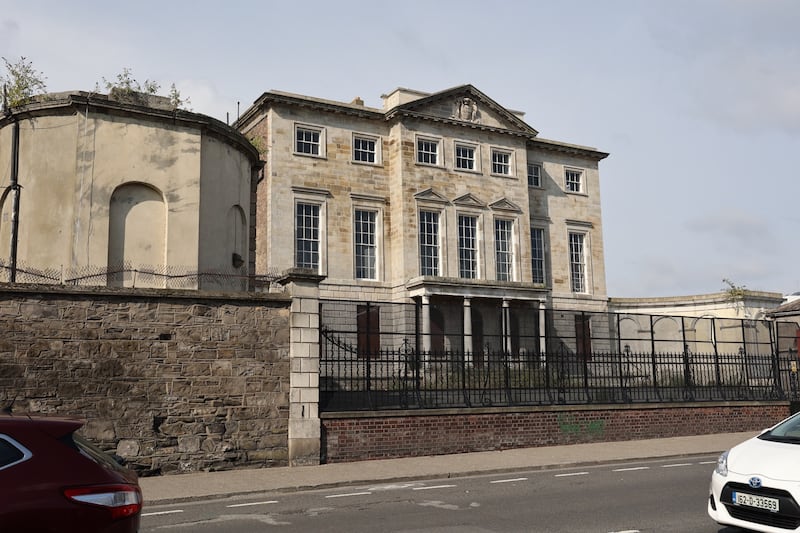
Aldborough House on Portland Row in the northeast inner city is the largest Georgian residence in the city after Leinster House and was the last Georgian mansion built in Dublin. The house, completed in 1803, has been vacant for more than 20 years and has suffered extensive damage to its roof and windows and serious internal deterioration from water ingress and vandalism.
The house was in State ownership throughout the 20th century until it was sold in 1999 to the Irish Music Rights Organisation (Imro) for use as its headquarters. This plan fell through in 2005 and Imro sold the house to a company called Aldborough Developments, which secured planning permission to convert it to a private hospital, but was subsequently wound up.
Five years ago, Reliance Investments Ltd, a company associated with machinery hire firm Pat O’Donnell and Company, was granted permission to develop the house for offices and construct two new five-storey “office wings” in its grounds, despite criticism of the scheme by the Department of Heritage and conservation organisations.
[ Heritage groups urge State to buy last great Georgian mansion built in DublinOpens in new window ]
However, the project did not go ahead, and while in the last two years external restoration works, part funded by the Government’s Historic Structures Fund, were undertaken to prevent further deterioration of the building, permission for the office development has now lapsed and no extension of permission has been sought within the required time.
The council said it has not had any contact with the owner in recent years in relation to the acquisition of the building.
A spokeswoman for Pat O’Donnell and Company said it had no comment to make on the matter. – Olivia Kelly
The Plough pub
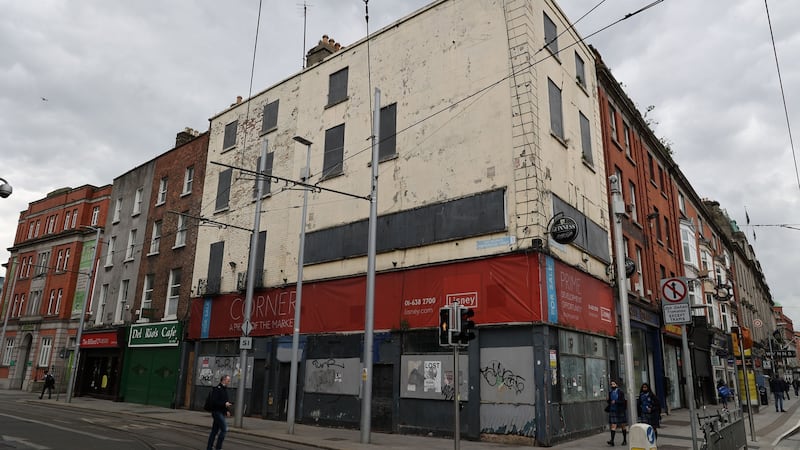
The Plough pub, at the corner of Abbey Street and Marlborough Street, had been a popular meeting spot for theatregoers but closed more than a decade ago. The four-storey Victorian building, which is on the record of protected structures, became increasingly dilapidated and by 2014 had been boarded up. In 2017, the council bought the pub for €850,000 to stop it from falling into further decay.
The council had initially hoped to reach a deal with the Abbey Theatre, which had “expressed an interest in utilising the buildings when refurbished”. However, no agreement was reached.
The council spent €80,000 dealing with a rodent infestation and emergency stabilisation works, but the building remained derelict. In June 2021 it secured the agreement of city councillors to sell the building to Equitas Properties, owned by Robert and Michael McCarthy, for €550,000. The company last year secured permission for its conversion into six apartments above a ground-floor shop.
The company has agreed to lease the apartments to the Peter McVerry Trust for permanent social housing for homeless people. – Olivia Kelly
77 Parnell Street
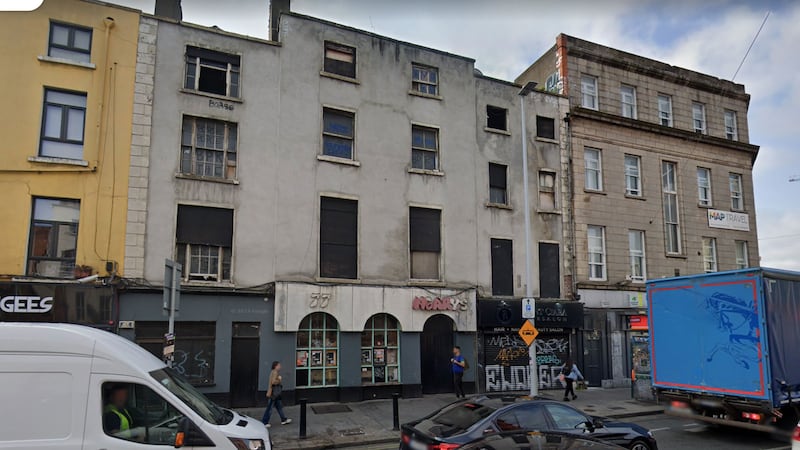
77 Parnell Street was built as a house around 1850 but was best known in the 20th century as Neary’s Pub, with an adjoining hotel under the same name. The building has been vacant for some 20 years and increasingly derelict for more than a decade.
The former owner, Ellen McGuill, died in 2002, with the property left to a Scottish Catholic bishop. However, the will was never executed due to Ms McGuill having no known living relatives to enact it, with a series of legal issues following.
In 2015, the building was taken over by squatters claiming to be anarchists, and was given the moniker the “Barricade Inn”. This group of squatters stayed for almost 12 months.
A company called Vandelure Ltd, a legal and business services firm, held freehold interest in the property but the company was dissolved in March 2021.
The property was placed on derelict register list in December of 2021, with the similarly dilapidated neighbouring No.76 kept off list due to a hair salon operating on ground floor.
The Dublin Civic Trust has called for the buildings’ restoration in a manner which is in keeping with the street’s “cultural and historical tradition”. – Rory Fleming
78-80 King Street North, Smithfield, Dublin 7
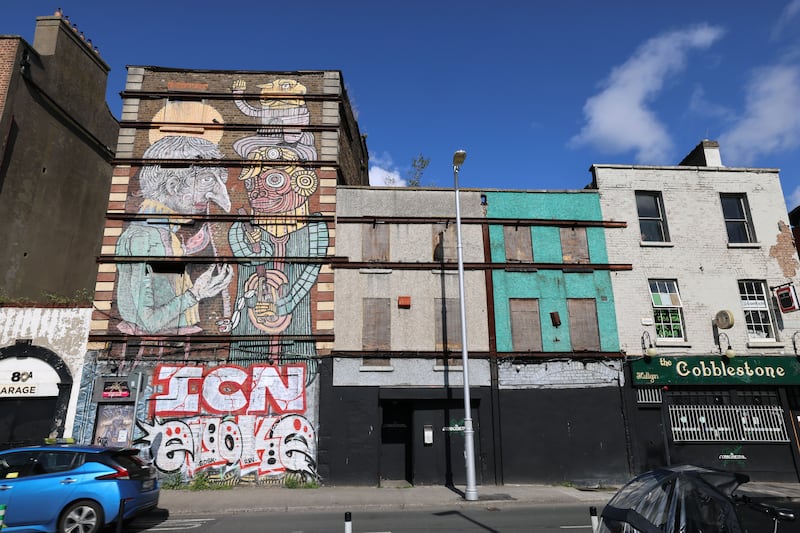
A group of buildings located next to the Cobblestone Pub at No.77 King Street North in Smithfield. Planning permission was sought to develop a nine-storey, 114 bedroom hotel on the site but this was rejected by Dublin City Council in 2021. More than 700 objections were received by the council and an online petition racked up 35,000 signatories.
Objectors described the plans as a “major overdevelopment” of the area, and criticised its “crude and obtrusive design”, which “engulfed protected structures”.
Development firm Marron Estates initially appealed this decision to An Bord Pleanála in late 2021, proposing a scaled-back development of seven-storeys and “the retention of the entire Cobblestone pub over all floors at basement, ground and first and second floors”, according to planning documents. However, it withdrew the appeal in April 2022.
The building at No.80 is covered by a painting depicting two musicians. This was painted in 2013 by Italian street artists Vadis and Tilf. – Rory Fleming
3 Parnell Street, Dublin 1:
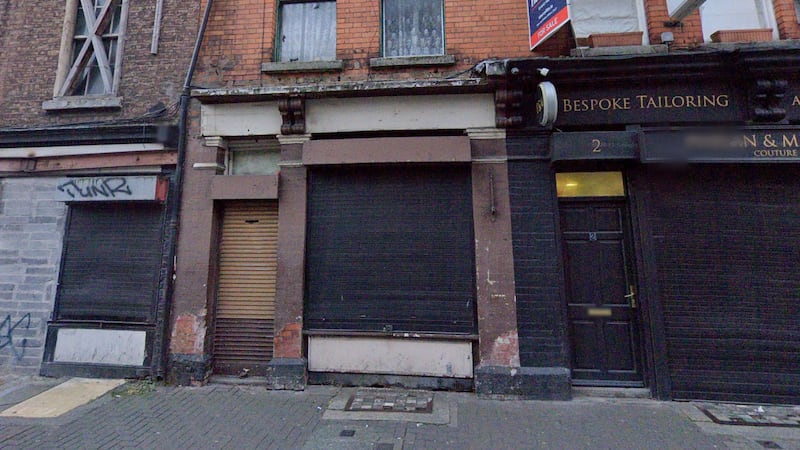
Located close to the junction between Parnell Street and Capel Street, the property was built between 1790 and 1810 and was originally used as a house, before later becoming home to shops.
A three storey building with traditional brick upper facade and sash windows, it is one of the oldest remaining structures along Parnell Street.
Planning permission was given to neighbouring plots numbers 4, 5 and 6 for the construction of a new five-storey building, but this had yet to be acted upon.
The building itself became structurally compromised following the demolition of the terrace to its east. Owner could not be identified. – Rory Fleming
19 and 21 Connaught Street, Dublin 7:
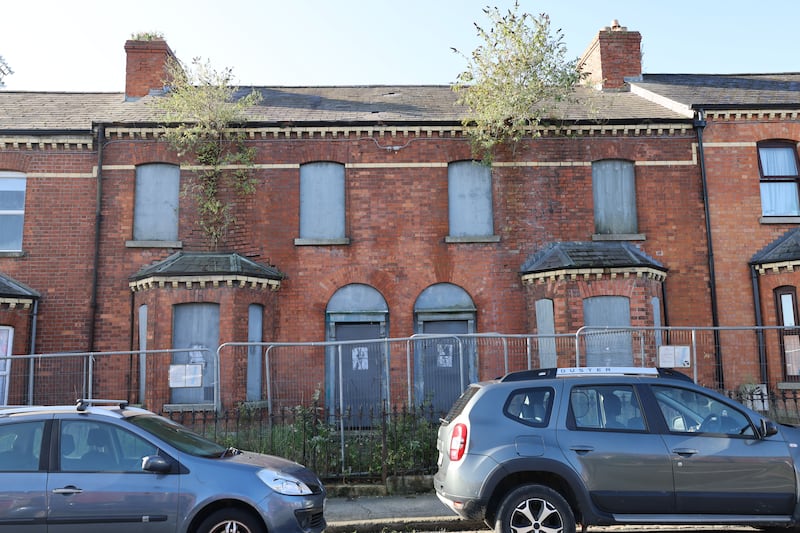
Located to the rear of Bohemians FC’s Dalymount Park, this pair of two storey Victorian homes have been lying derelict since the 1980s.
The site was first placed on the Derelict Sites Register in 2009, after the buildings had been boarded up a number of years previously.
In 2012, the properties were taken off the Derelict Sites Register due to minor brickwork being undertaken which satisfied Dublin City Council enough to allow its removal.
The properties’ owners didn’t carry out any further works though, and they have been left unused ever since. Locals have in the past campaigned to have the sites placed back on the register in order for a purchase order to implemented.
The council placed the buildings back on the register in 2018, along with examining the chance of potentially placing a compulsory purchase order (CPO) on the sites.
The stated owner, a Patrick Joseph Gallagher, opposed this in 2019, along with council planning inspector Colm McLoughlin who stated after review that the property was not in his opinion a derelict site.
However, the CPO went ahead as planned later on that year. The council has not yet redeveloped the sites, citing the need for the interiors of the buildings to be stabilised before proper renovations could be undertaken.
The council in November of 2022 decided the buildings had deteriorated to such an extent that they would need to be demolished and rebuilt with just their facades retained. – Rory Fleming
43-50 Dolphin’s Barn Street, Dublin 8:
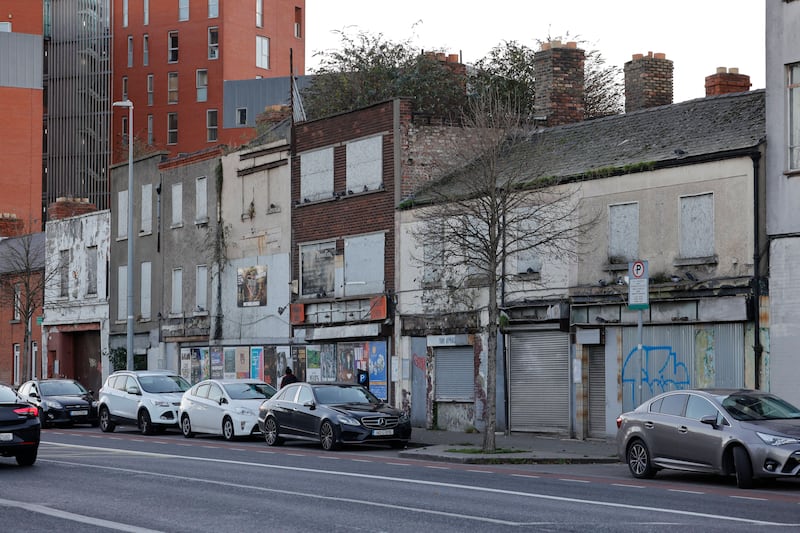
A row of shops and an old factory building which are listed on Dublin City Council’s Derelict Site Register.
Factory was DC Kavanagh Printers, which was one of Ireland’s biggest print and mailing companies.
The retail units began to shut down one by one in the 1980s, with the final one closing in the late 1990s.
This row of shops included a chipper, a shoemakers, a bakery and a florists.
When the shops became derelict, they were purchased by Conor Kavanagh of DC Kavanagh Printers.
However, the units were never redeveloped and the firm went into receivership in 2012, with Smith and Williamson Freaney appointed as the receivers.
Properties were issued as mixed-use zoning and placed on the market in 2016.
In December of 2021, Majack Hour Ltd, a Northern Ireland-based company, applied for “strategic housing redevelopment”.
In April of 2022, permission was granted for the demolition of the buildings, along with the go-ahead for the company to build 116 build-to-rent apartments and an anchor commercial unit.
Building has yet to start on these works despite approval being granted. Majack Hour did not respond to a request for a comment. – Rory Fleming
Liffey Vale, Chapelizod Road, Dublin 20

Liffey Vale House is a two-storey derelict dwelling located on the northern banks of the river Liffey, along the Chapelizod Road. Planning permission has been granted to Dublin City Council for the derelict house and gardens to be redeveloped into a combination of a new biodiversity education centre, cafe and extension of Liffey Valley Park.
Work was due to begin in early 2022 but was then pushed back.
According to Dublin City Council’s Parks, Landscape and Biodiversity Department, the site will “offer the opportunity for all to spend time in nature, and learn about animals, plants, and ecological systems that thrive in close proximity to the city and along the river’s edge”.
Liffey Vale previously housed a family who cared for a garden and orchard along the Liffey’s edge.
The redevelopment will provide a “culturally relevant stop on a daily walk or weekend cycles”, according to the report by the council.
The grounds at Liffey Vale are planned to open on to a series of paths which will be built to allow universal access through a range of natural features, including woodland, wetland and the river itself.
The council did not respond to a request for a comment. – Rory Fleming
2-3 Mark’s Alley West, Dublin 8:

The two houses were built in 1847 and were set to be demolished as part of plans for a new 37-bed hotel development.
In 2021, planning permission sought by Plunkett Homes for a 19-bed aparthotel was rejected by Dublin City Council but was then approved following appeal by An Bord Pleanála.
However, revised plans for the 37-bed hotel were submitted to the council which it rejected in March of 2023, over concerns it would “exacerbate the existing over-concentration of tourist and visitor accommodation in the area.”
Planning documents submitted by Peninsula Suite Holdings state that the buildings on Mark’s Alley West are in “severely dilapidated condition”.
It was not the first time plans for a repurposing this site have fallen through, with developer Eamonn Walsh seeking planning approval for a 38-apartment development back in 2004 that was refused by both the council and Bord Pleanála.
The properties are still lying derelict. Peninsula Holdings did not respond to a request for a comment. – Rory Fleming
94 Marlborough Street, Dublin 1:
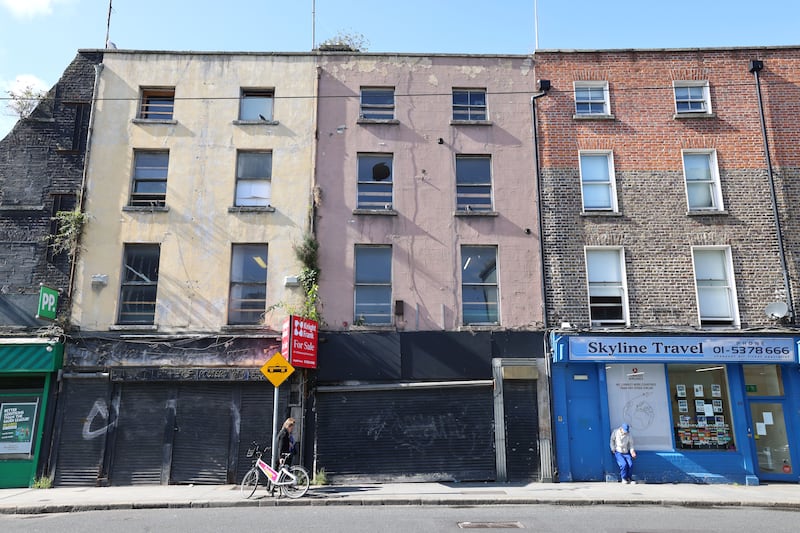
Four-storey building located in Dublin’s North inner city built in 1750.
Located within the O’Connell Street Architectural Conservation area, with typical sash windows and a plastered facade.
The property, along with the adjoining 95 Marlborough Street site, have been lying vacant for close to two decades and are now in extremely poor condition.
According to National Inventory of Architectural Heritage, the property holds a quintessential Georgian facade which “greatly enhances the character and appearance of the streetscape.”
Currently on the market and listed by Knight Frank Estate Agents without a price. – Rory Fleming
10-13 Conyngham Road (Parkgate Street)
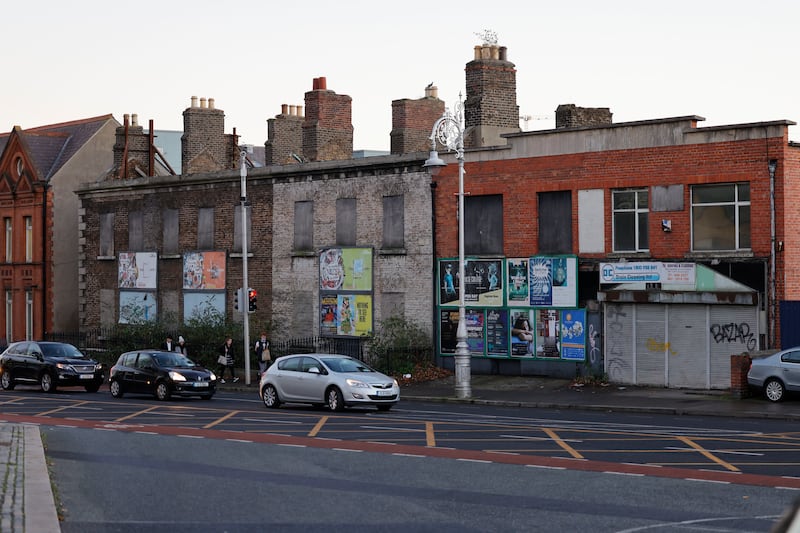
Situated opposite Criminal Courts of Justice before main gates of Phoenix Park and next to Dublin Region Homeless Executive Central Placement Service.
A row of Victorian houses which are now derelict and owned by CIÉ.
The buildings were included in “Heuston Masterplan” to revitalise the area, with No.10 proposed to be knocked down to accommodate a new bridge across the Liffey to behind Heuston Station. This proposed development is not due to be completed until 2038 though, should plans be approved.
According to Green MEP Ciaran Cuffe, the houses have been lying vacant for more than 40 years and “epitomise the State’s neglect of inner-city properties”.
They were officially declared derelict by the council under Section 3 of Derelict Sites Act, 1990, in April 2019. – Rory Fleming
Rialto Cinema

The Rialto Cinema opened in November 1936 and was one of biggest in country, with 1,600 seats.
It closed in late 1970 or early 1971 and was repurposed as a car dealership for Windsor Motors.
Windsor Motors vacated the premises in the late 1990s, with no one else taking up tenancy and it has remained vacant since.
Marziplant Limited was in control of the premises by the 2010s and applied for planning permission for redevelopment in 2015 but this was rejected.
The building was sold in November 2017 to an unnamed party by BNP Paribas for €2.7 million, which was €200,000 above its guide price.
In 2019 Molaga Capital applied for planning permission for 317-bedroom student accommodation complex, with cafe, gym and outdoor garden area included. Permission was granted in November of that year.
The company is linked to Belgian millionaire Didier de Witte, who has previously been sentenced to jail time in his home country over tax evasion.
Work has yet to get under way on the site and Molaga Capital did not respond to queries. – Rory Fleming
23-25 Ballybough Road
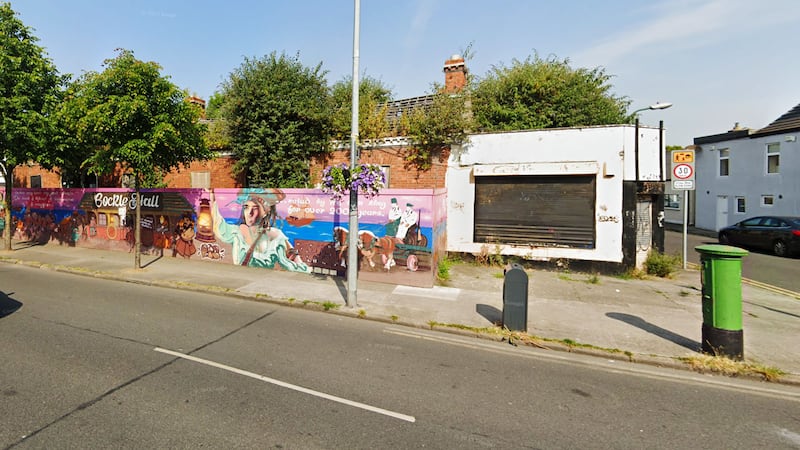
Row of properties which have been derelict since early 2000s but 23-25 was only placed on Derelict Sites Register in July 2017.
The buildings have passed through the ownership of several connected companies over the past decade.
They were owned by nearby business Annesley Motors, located at No. 26. Balmar Property Ltd owned the sites, having purchased them after previous owners the Maybourne Company went into receivership in 2014. Jason Byrne, a director at Maybourne, is also a director at Annesley Motors.
Aungier Street Properties bought the sites in 2015 for €1.4 million. The secretary of Aungier was Seán Browne, who is now a director at Balmar.
The site was placed back on market in 2018 for price of €5.5 million, a near 400 per cent mark up in just two years.
Site has full planning permission for a mixed-use scheme and was advertised for sale with a feasibility study stating that up to 285 student accommodation bedrooms could be built on site.
In 2006, planning permission was granted for six storey building which would include car park, six retail units and 46 apartments.
Permission was granted but never acted upon. In 2012, Maybourne reapplied to have permission for an off-licence to be included, but this was denied. – Rory Fleming
162-165 James Street, Dublin 8.
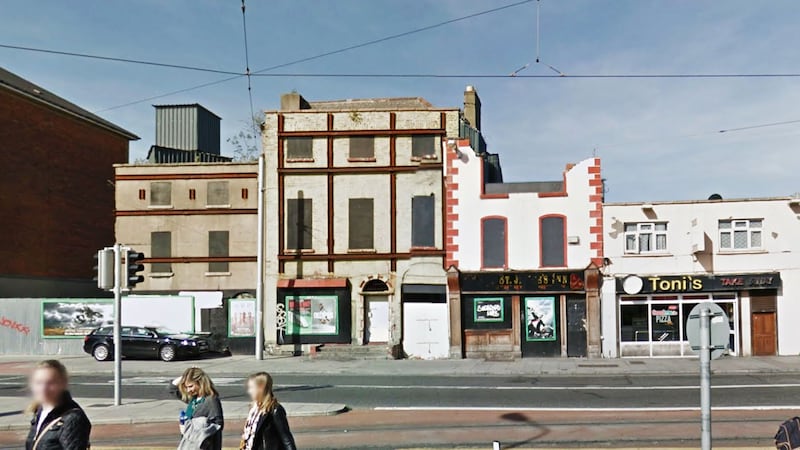
No.162 was formerly O’Malley’s Pub and later became The St. James’ Inn. No. 163 was a leather maker before becoming a dry cleaners and No.164-165 were both tenement houses.
In 1999, Ardenhall developments applied for planning permission for 163 and 164 to build 23 one- and two-bed apartments with underground parking. Permission was denied by the council, which said it would further erode the road’s traditional streetscape.
In 2004, the site was auctioned off for €2.3 million with full planning permission for 18 apartments included.
No.163 is listed as a protected structure by Dublin City Council. Built around 1800, it “retains its early scale and proportions typical of Georgian Dublin townhouses”, as per National Inventory of Architectural Heritage.
Thomas O’Connor, James Campion and Donal Connelly applied for planning in 2003 to redevelop 163-165, seeking to build apartments.
Permission was granted but under condition that 164 as well as 163 was treated as a protected buildings.
Numbers 162-165 have been on the Derelict Sites Register since June 2019.
In August 2022, the council instigated a compulsory purchase order on the buildings but the order was not completed after an owner surfaced and objected.
Ultimately, the HSE purchased the properties for a combined total of €2.425 million in March of 2023 (the properties are opposite the Coombe Hospital). The site also backs on to St. James’s Hospital medical records warehouse on Bow Lane. –Rory Fleming














